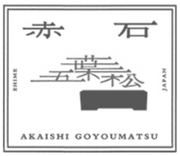Why Akaishi Goyomatsu is so popular

Goyomatsu Yamadori
Yamadori bonsai is a type of bonsai in which a small tree growing naturally in the mountains is collected, planted in a pot and finished as a bonsai. Compared to trees grown in the field or in pots, the natural growth of the tree gives the trunk texture and a strong vitality that makes it more valuable as a bonsai.
In the 1950's, there were many Goyomatsu growing in the Akaishi mountain area, and the trees that were picked from the mountain were called "Yama-gori" (mountain picking), and they were so popular that people from the Kanto area came to buy them.
The alpine plants around the summit of Mt. Akaishi are designated as a natural monument by Ehime Prefecture ("Alpine Plants of Mt. Akaishi," December 14, 1957), and are regulated by an ordinance that forbids collecting them without permission.
From Yamadori to Seedling Production

With the increase in demand, the seedlings collected in the mountains were exhausted, so the method of collecting seeds in the mountains, growing seedlings from the seeds, and preparing seedling changed.
At that time, seed collection was done from the opening day of the season on August 25 until around September 10. After climbing up the mountain with ropes wrapped around their bodies, they would collect the pine needles by hooking the ropes and pulling in the branches. It was a dangerous job, working on a steep slope.
The method of seedling preparation has been handed down to the present, and although the dangerous method of collection is no longer used, pine scales are collected from pines planted in the field.
Collecting the seeds

The best time to collect seeds is from late August to mid-September, when the pine cones are still green and not fully opened. Once the pine cones are collected, they should be stored in a place away from sunlight.
 The pine cones will gradually become darker brown and the cones will open. Remove the seeds from the open capsules. The seeds are easy to pull out with tweezers. The seeds are covered with thin feathers. Hold the brown seed grain and gently pull on the feather to easily remove it.
The pine cones will gradually become darker brown and the cones will open. Remove the seeds from the open capsules. The seeds are easy to pull out with tweezers. The seeds are covered with thin feathers. Hold the brown seed grain and gently pull on the feather to easily remove it.

If the seeds are then placed in water, the best seeds will generally sink, the second best seeds will sink when pushed by hand, and the poorest seeds will not sink at all. The seeds are divided into three categories: good seeds, second-best seeds, and bad seeds.
After sorting, dry the seeds, put them in paper bags or jute bags, and store them in a cool place with no humidity until they are ready to be sown.
The stored seeds are then sown at the end of February or beginning of March of the year after collection, when the temperature has not yet risen to 15℃ or lower.
If the seeds are covered with plastic after sowing, they will germinate in late March to mid-April.
How to grow germinated Goyomatsu from seed

The first year's seedling management consists mainly of irrigation and pest control.
In the second year, the seedlings are transplanted between late January and late March. In addition, fertilization is done once a month from the end of the rainy season until early November, when the seedlings are at their thickest.
In the third year, if the seedlings grow well, the number of branches will increase and the trunk will become somewhat thicker. Disinfect and fertilize in the same way as the second year. The most important thing to do is to pick the buds from mid-May to mid-June. If spring buds cannot be processed, fall buds should be processed in September or October.
In the fourth year, transplanting is done as in the second year, from February to April. Also, remove branches from the tree every other year, as cutting them all at once will cause imbalance with the roots.

From the fifth year on, when the trunks start to grow, transplanting, disinfecting, fertilizing, picking buds, and removing branches are repeated to keep the trunks thick and short. Trunks grown in the field are much thicker than those grown in pots.
It is after the 8th year that the skeleton is formed as a bonsai. At this time, the branches are trimmed while considering the balance between unnecessary and thick branches and roots.
Potting up is done in the 10th to 12th year. Akaishi Goyomatsu (five leaf pine) is finally ready to be a bonsai. After potting up the tree, it is time to do some serious branching and plant it in a pot suitable for its trunk size and height.
At the end of the Showa era (1926-1989), seedlings harvested from the mountains were cultivated in the same way as seedlings, including transplanting, disinfecting, fertilizing, picking buds, and removing branches.
Seedling Akaishi Goyomatsu Bonsai
In the town of Doi, Ehime Prefecture, many craftsmen protect the original species of Akaishi Goyomatsu, sowing the seeds and creating bonsai over a long period of time.
This is not something that can be done in a few years, but takes ten to a hundred years to complete. Many of us have inherited our Goyomatsu from our grandfathers or older generations.
The seeds sown now may not become bonsai in their own generation. Nevertheless, the craftsmen continue to sow the seeds to preserve the nature of Akaishi Mountain for future generations.




